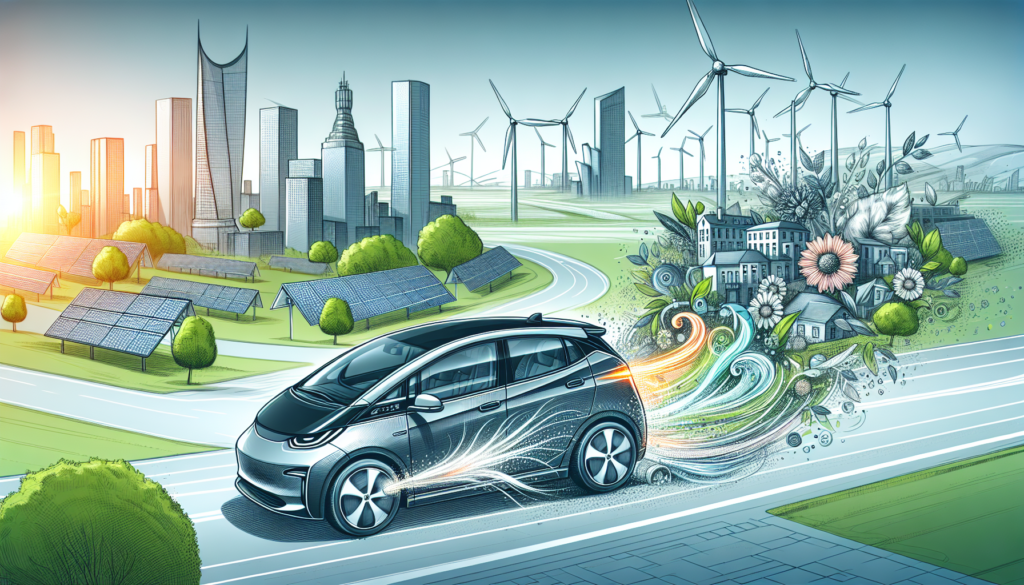Electric vehicles have become a popular and promising solution to reduce air pollution, but what impact do they really have? With rising concerns about environmental degradation and the need for cleaner transportation options, the adoption of electric vehicles has gained momentum. This article explores the positive effects of electric vehicles on reducing air pollution and examines how they contribute to a greener future. From decreasing greenhouse gas emissions to improving air quality in urban areas, electric vehicles have the potential to revolutionize our transportation systems and create a healthier and more sustainable environment for all.

Environmental Benefits of Electric Vehicles
Reduction in Greenhouse Gas Emissions
Electric vehicles (EVs) have a significant advantage over internal combustion engine (ICE) vehicles when it comes to reducing greenhouse gas (GHG) emissions. Unlike ICE vehicles that rely on fossil fuels, EVs produce zero tailpipe emissions. This means that by transitioning to electric vehicles, we can greatly reduce the amount of carbon dioxide, methane, and other greenhouse gases released into the atmosphere. This reduction in GHG emissions is crucial for mitigating climate change and working towards a more sustainable future.
Improvement in Air Quality
One of the most noticeable benefits of electric vehicles is the improvement in air quality. Traditional ICE vehicles emit a wide range of pollutants, including nitrogen oxides (NOx), volatile organic compounds (VOCs), and particulate matter (PM). These pollutants contribute to the formation of smog and are harmful to human health. On the other hand, electric vehicles produce no tailpipe emissions and therefore help to significantly reduce air pollution. By driving an electric vehicle, you can contribute to cleaner air and create a healthier environment for everyone.
Decrease in Noise Pollution
Another advantage of electric vehicles is the decrease in noise pollution. Unlike ICE vehicles that have noisy engines, electric vehicles operate silently. This reduction in noise pollution has a positive impact on urban areas where traffic congestion and noise pollution are major concerns. By choosing an electric vehicle, you can enjoy a quieter and more peaceful driving experience while also contributing to a less noisy environment for others.
Comparison of Electric Vehicles and Internal Combustion Engine Vehicles
Lower Emissions from Electric Vehicles
When comparing electric vehicles to internal combustion engine vehicles, it is clear that EVs have significantly lower emissions. As mentioned earlier, EVs produce no tailpipe emissions, which means they do not release pollutants such as carbon monoxide (CO) and nitrogen oxides (NOx) into the air. This is a major advantage in terms of air quality improvement and reducing the negative impacts of transportation on our environment.
Higher Emissions from Internal Combustion Engine Vehicles
In contrast to electric vehicles, internal combustion engine vehicles emit a wide range of pollutants. Besides the previously mentioned carbon monoxide and nitrogen oxides, ICE vehicles also release carbon dioxide (CO2) and particulate matter (PM). These emissions contribute to climate change, poor air quality, and negative health effects. The significant difference in emissions between electric and internal combustion engine vehicles highlights the importance of transitioning to electric vehicles to reduce the environmental impact of transportation.
Reducing Air Pollution by Transitioning to Electric Vehicles
Transitioning to electric vehicles is a vital step in reducing air pollution. By replacing internal combustion engine vehicles with electric vehicles, we can greatly reduce the release of pollutants into the atmosphere. This reduction in air pollution has numerous positive effects, including better health outcomes, improved air quality in urban areas, and a lower carbon footprint. Governments, industries, and individuals all have a role to play in promoting the widespread adoption of electric vehicles as a solution to air pollution.
Factors Influencing the Reduction of Air Pollution
Usage of Renewable Energy Sources
The source of electricity used to charge electric vehicles plays a crucial role in determining their environmental impact. If the electricity is generated from renewable sources such as solar, wind, or hydropower, the emissions associated with charging electric vehicles are virtually zero. On the other hand, if fossil fuels are used to generate electricity, there will still be emissions attributable to EV charging. Promoting the adoption of renewable energy sources for electricity generation is therefore a key factor in maximizing the environmental benefits of electric vehicles.
Efficiency of Electric Vehicles
The efficiency of electric vehicles also plays a role in reducing air pollution. EVs are generally more energy-efficient compared to internal combustion engine vehicles. This means that for the same distance traveled, electric vehicles require less energy, resulting in lower emissions. Additionally, advancements in battery technology and regenerative braking systems further improve the efficiency of electric vehicles, making them an even more sustainable transportation choice.
Driving Habits and Patterns
Individual driving habits and patterns can influence the reduction of air pollution associated with electric vehicles. For example, driving at higher speeds or accelerating aggressively can decrease the range of an electric vehicle and increase energy consumption. By adopting eco-friendly driving habits such as maintaining a steady speed, avoiding unnecessary acceleration, and utilizing regenerative braking, drivers can optimize the energy efficiency of their electric vehicles and reduce emissions.
Electric Vehicles and Particulate Matter Emissions
Lower Particulate Matter Emissions
One of the significant advantages of electric vehicles is their lower particulate matter emissions. Particulate matter, or PM, refers to microscopic solid or liquid particles suspended in the air. These particles can be emitted directly from exhaust systems or indirectly from the combustion process in internal combustion engines. Electric vehicles produce no tailpipe emissions, eliminating particulate matter emissions entirely. This is especially important for urban areas where high levels of particulate matter can lead to respiratory issues and other health problems.
Impact on Health and Air Quality
Reducing particulate matter emissions through the use of electric vehicles has a direct positive impact on human health and air quality. PM can penetrate deep into the lungs and even enter the bloodstream, causing respiratory and cardiovascular problems. By minimizing or eliminating PM emissions, electric vehicles contribute to healthier air quality and a reduced risk of these harmful health effects. This is particularly beneficial in densely populated urban areas, where air pollution can have a significant impact on public health.

Reducing Air Pollution in Urban Areas with Electric Vehicles
Benefits for City Dwellers
Electric vehicles offer numerous benefits for city dwellers concerned about air pollution. With their zero tailpipe emissions, EVs can significantly reduce the amount of pollution generated in urban areas. This is particularly important for densely populated cities where air pollution is a major health and environmental concern. By driving electric vehicles, city dwellers can contribute to cleaner air, creating a healthier and more enjoyable living environment for themselves and future generations.
Impacts on Public Health
Air pollution in urban areas has a direct impact on public health. Poor air quality caused by emissions from vehicles and industrial activities can lead to respiratory problems, allergies, and other health issues. Electric vehicles, with their lower emissions and zero tailpipe pollution, offer a solution to this problem. By reducing air pollution in urban areas, EVs can help to improve public health outcomes, resulting in fewer cases of respiratory diseases, improved well-being, and a higher overall quality of life for urban residents.
Improved Quality of Life
The use of electric vehicles in urban areas can lead to an improved quality of life for both residents and visitors. Cleaner air, reduced noise pollution, and less dependency on fossil fuels all contribute to a more sustainable and livable urban environment. The transition to electric vehicles supports a shift towards a greener and more resilient city, making it a more attractive place to live, work, and visit. Electric vehicles play a crucial role in creating cities that prioritize the well-being of their residents and the sustainability of their infrastructure.
Challenges and Limitations of Electric Vehicles in Reducing Air Pollution
Dependence on Electricity Grid
A significant challenge in using electric vehicles to reduce air pollution is the dependence on the electricity grid. The charging infrastructure required to support widespread electric vehicle adoption needs to be developed and expanded to meet the increasing demand. Additionally, the electricity grid itself must be decarbonized, transitioning from fossil fuel-based generation to renewable energy sources. Without addressing these challenges, electric vehicles may simply shift emissions from tailpipe to power plant if the electricity used for charging is not clean.
Battery Production and Disposal
The production and disposal of electric vehicle batteries also present challenges in terms of their environmental impact. The extraction of raw materials, manufacturing processes, and end-of-life disposal all contribute to the overall life cycle environmental footprint of electric vehicle batteries. However, advancements in battery technology have led to improvements in energy density, charging speed, and lifespan, reducing the environmental impact. Additionally, efforts are being made to develop recycling and repurposing systems to minimize waste and extend the lifespan of electric vehicle batteries.
Infrastructure for Charging Stations
The availability and accessibility of charging stations present a significant challenge for electric vehicle adoption. The infrastructure for charging stations needs to be developed and expanded to ensure that electric vehicle owners have convenient access to charging facilities. This is particularly important for long-distance travel and areas with limited charging infrastructure. Governments and private entities need to collaborate to build a reliable and comprehensive network of charging stations to support the widespread use of electric vehicles and further reduce air pollution.
Government Initiatives to Promote Electric Vehicles
Incentives and Subsidies
Governments around the world are implementing various incentives and subsidies to encourage the adoption of electric vehicles. These measures aim to make electric vehicles more affordable and accessible to consumers. Incentives may include financial incentives such as tax credits, rebates, and grants, as well as non-financial benefits like preferential access to carpool lanes or reduced parking fees. By providing these incentives, governments can encourage individuals and businesses to transition to electric vehicles, driving the market towards cleaner and more sustainable transportation options.
Development of Charging Infrastructure
To support the widespread adoption of electric vehicles, governments are investing in the development of charging infrastructure. This includes the installation of public charging stations in urban areas, along highways, and in parking facilities. Governments are also working with private industry partners to expand the network of fast-charging stations and ensure their compatibility with different electric vehicle models. The development of a reliable and widespread charging infrastructure is essential for addressing range anxiety and facilitating the transition to electric vehicles.
Phasing out Internal Combustion Engine Vehicles
Some governments have set ambitious targets to phase out the sale of internal combustion engine vehicles entirely. By implementing regulations and policies that encourage the adoption of electric vehicles, governments can accelerate the transition to a cleaner transportation system. These measures may include setting specific deadlines by which new vehicle sales must be electric, implementing stricter emissions standards for internal combustion engine vehicles, and providing incentives for electric vehicle charging infrastructure. Phasing out internal combustion engine vehicles is a bold step towards reducing air pollution and mitigating climate change.
Future Outlook and Potential Impact on Air Pollution Reduction
Increasing Adoption of Electric Vehicles
The future of transportation is undoubtedly electric. With ongoing advancements in technology, increasing affordability, and supportive government initiatives, the adoption of electric vehicles is expected to accelerate in the coming years. As more individuals and businesses choose electric vehicles over internal combustion engines, the overall impact on air pollution reduction will be significant. The widespread use of electric vehicles has the potential to reduce pollution levels, improve air quality, and contribute to the global efforts to combat climate change.
Technological Advancements
Technological advancements in the electric vehicle sector are continuously improving their overall efficiency, range, and charging capabilities. Batteries are becoming more energy-dense, allowing for longer driving ranges, while charging times are decreasing and the availability of fast-charging stations is expanding. Additionally, research and development efforts are focused on enhancing the sustainability of electric vehicle manufacturing processes and improving battery recycling programs. These technological advancements will further enhance the environmental benefits of electric vehicles and make them more attractive to consumers.
Collaboration between Industries and Government
Collaboration between industries and government entities is crucial for driving the transition to electric vehicles and reducing air pollution. Governments must work with automakers, energy companies, and other stakeholders to develop comprehensive strategies and policies that support the growth of the electric vehicle market. This collaboration can facilitate the sharing of knowledge, resources, and best practices, leading to significant advancements in electric vehicle technology, infrastructure, and sustainability. Together, industries and governments can create a cleaner and more sustainable transportation system.
Conclusion
Electric vehicles offer tremendous environmental benefits in terms of reducing greenhouse gas emissions, improving air quality, and decreasing noise pollution. By transitioning to electric vehicles, we can significantly reduce the negative impact of transportation on our environment and work towards a more sustainable future. Factors such as the usage of renewable energy sources, the efficiency of electric vehicles, and individual driving habits all influence the reduction of air pollution associated with electric vehicles. While there are challenges and limitations to overcome, government initiatives, technological advancements, and collaboration between industries and government entities pave the way for a cleaner and healthier future. The increasing adoption of electric vehicles, together with ongoing advancements in technology and supportive policies, holds the potential to make a significant impact on reducing air pollution and creating a more sustainable world.

